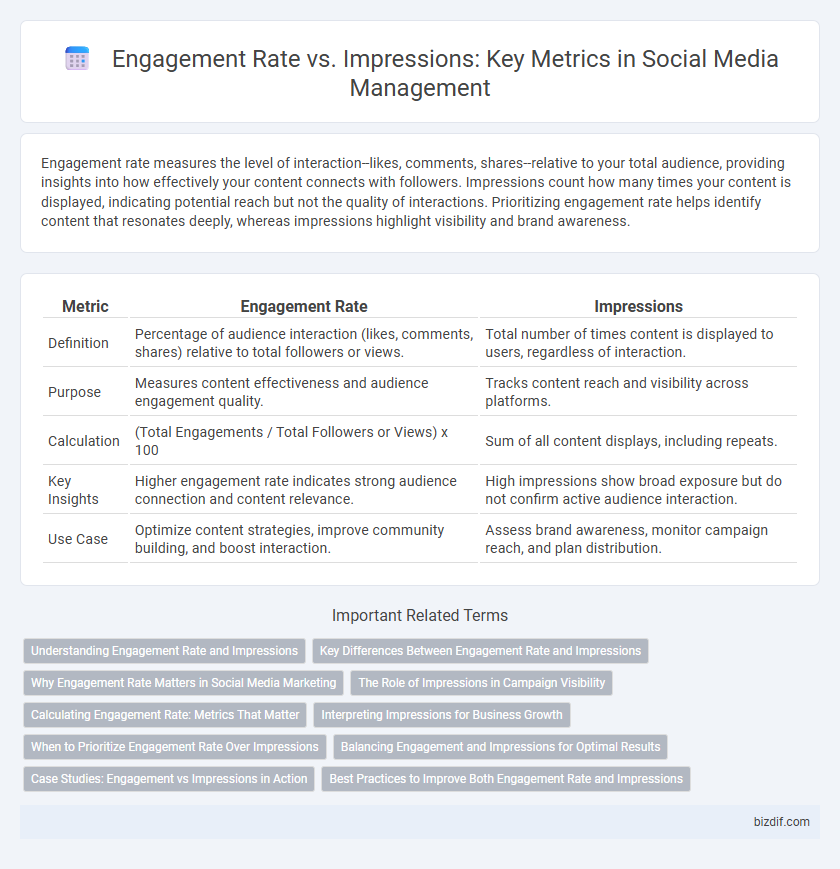Engagement rate measures the level of interaction--likes, comments, shares--relative to your total audience, providing insights into how effectively your content connects with followers. Impressions count how many times your content is displayed, indicating potential reach but not the quality of interactions. Prioritizing engagement rate helps identify content that resonates deeply, whereas impressions highlight visibility and brand awareness.
Table of Comparison
| Metric | Engagement Rate | Impressions |
|---|---|---|
| Definition | Percentage of audience interaction (likes, comments, shares) relative to total followers or views. | Total number of times content is displayed to users, regardless of interaction. |
| Purpose | Measures content effectiveness and audience engagement quality. | Tracks content reach and visibility across platforms. |
| Calculation | (Total Engagements / Total Followers or Views) x 100 | Sum of all content displays, including repeats. |
| Key Insights | Higher engagement rate indicates strong audience connection and content relevance. | High impressions show broad exposure but do not confirm active audience interaction. |
| Use Case | Optimize content strategies, improve community building, and boost interaction. | Assess brand awareness, monitor campaign reach, and plan distribution. |
Understanding Engagement Rate and Impressions
Engagement rate measures the percentage of interactions, such as likes, comments, and shares, relative to the total number of impressions, which represent how many times a post is displayed. High engagement rates indicate content relevance and audience interest, while impressions solely reflect visibility without indicating active participation. Analyzing both metrics helps optimize social media strategies by balancing reach and user interaction for better campaign performance.
Key Differences Between Engagement Rate and Impressions
Engagement rate measures the percentage of active interactions, such as likes, comments, and shares, relative to the total audience, reflecting the level of audience involvement with the content. Impressions indicate the total number of times a post is displayed, regardless of user interaction, providing insight into content visibility and reach. The key difference lies in engagement rate evaluating quality and interaction, while impressions quantify exposure and potential audience size.
Why Engagement Rate Matters in Social Media Marketing
Engagement rate measures the quality of interactions like likes, comments, and shares relative to total followers or impressions, highlighting content resonance with the audience. Unlike impressions that only quantify how many times a post is seen, engagement rate reveals active user participation and genuine interest, which drives brand loyalty and conversions. High engagement rates signal effective social media strategies and help marketers optimize content for meaningful audience connections.
The Role of Impressions in Campaign Visibility
Impressions measure the total number of times your content is displayed, playing a crucial role in maximizing campaign visibility across social media platforms. Higher impressions increase the potential reach, exposing your brand to a broader audience and enhancing awareness. Monitoring impressions alongside engagement rate helps optimize content strategy for improved visibility and audience interaction.
Calculating Engagement Rate: Metrics That Matter
Engagement rate measures the percentage of interactions, such as likes, comments, and shares, relative to total impressions or reach, providing insight into content effectiveness. Accurate calculation involves dividing total engagements by impressions and multiplying by 100 to express the rate as a percentage. Key metrics include likes, comments, shares, saves, and clicks, all critical in assessing audience interaction quality beyond sheer visibility.
Interpreting Impressions for Business Growth
Interpreting impressions in social media management reveals the total number of times content is displayed, providing insights into brand visibility and audience reach. High impressions indicate strong content exposure but must be analyzed alongside engagement rate to assess actual audience interaction and campaign effectiveness. Leveraging impressions data helps businesses identify trending content, optimize posting times, and refine targeting strategies for sustainable growth.
When to Prioritize Engagement Rate Over Impressions
Engagement rate is prioritized over impressions when the goal is to measure the quality of audience interaction, such as likes, comments, shares, and clicks, rather than just the volume of views. Brands aiming to build a loyal community or drive conversions benefit more from tracking engagement rate, as it reflects active user participation and content relevance. High impressions with low engagement indicate visibility without impact, whereas a strong engagement rate signifies meaningful connections and effective social media strategies.
Balancing Engagement and Impressions for Optimal Results
Balancing engagement rate and impressions is crucial for effective social media management, as high impressions without quality engagement often indicate low audience interaction. Prioritizing content that encourages likes, comments, and shares while maintaining a steady flow of impressions enhances brand visibility and fosters community growth. Optimizing this balance ensures campaigns reach a broad audience and generate meaningful user engagement, driving better overall performance.
Case Studies: Engagement vs Impressions in Action
Case studies reveal that a high engagement rate often correlates with content relevance rather than sheer impression volume, emphasizing quality over quantity. Brands like Nike demonstrate that targeted campaigns with moderate impressions can yield engagement rates 2-3 times higher than broad-reach tactics. This insight underlines the importance of optimizing content strategy to foster meaningful interactions, not just maximizing reach.
Best Practices to Improve Both Engagement Rate and Impressions
Maximizing engagement rate and impressions requires a strategic focus on creating high-quality, relevant content tailored to the target audience's interests and behaviors. Leveraging data analytics to identify peak posting times and optimize post frequency enhances visibility and interaction across platforms. Incorporating interactive elements such as polls, questions, and multimedia further stimulates user participation, driving both higher impressions and deeper engagement.
Engagement rate vs Impressions Infographic

 bizdif.com
bizdif.com